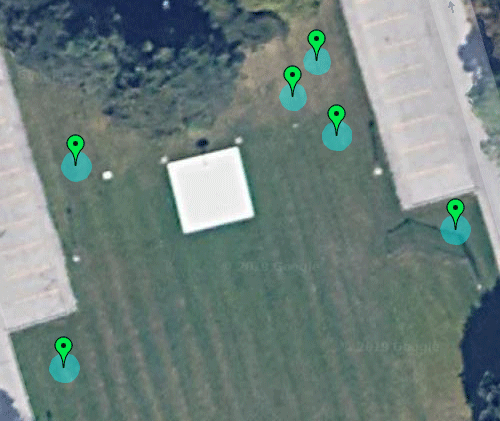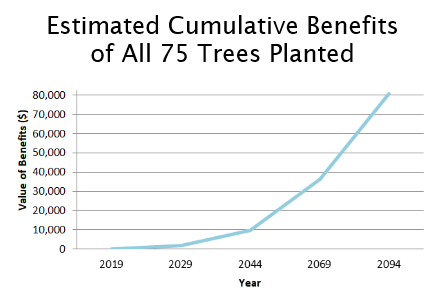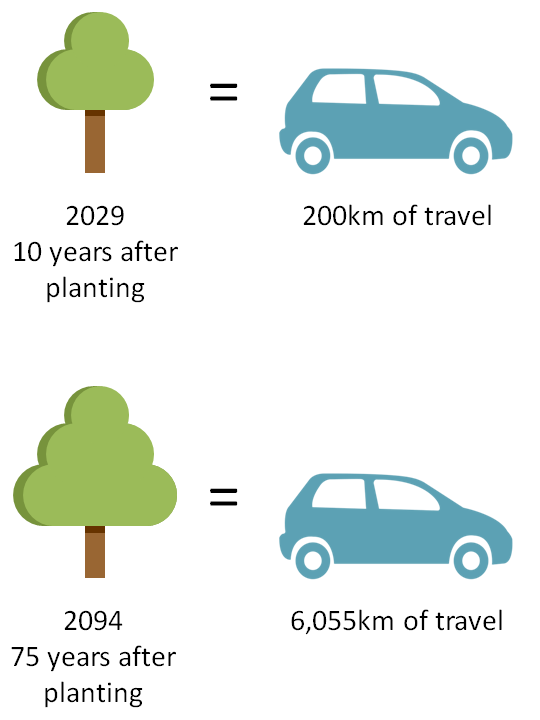
Picture this: something exists that cleans the water and air, cools the neighborhood, provides yummy food, is a home for animals and looks beautiful too. What did you picture? I bet it was a tree, and not just because the title spoiled the answer, but because these are all things that our leafy friends do.
Over its lifetime, a tree will provide a wide range of benefits that increase with each year of growth. This is good for communities that have few trees, as they stand to gain the most from tree planting. Recognizing the need for more tree cover and greater species diversity we worked with TCH, the City of Toronto, Park People and other partners, to plant 75 new trees across eight TCH sites in 2019. As these trees take root, they will provide benefits for decades to come. But what is the value that these trees bring to the community?
Estimated Cumulative Benefits of all 75 Trees Planted
Using a free online tool called i-Tree Design, an estimation of the benefits and services which trees provide can be calculated based on the planting location, species, the tree’s size and its condition.
We used the tool to calculate the cumulative benefits of 75 new trees over a number of years. The benefits included in the numbers below are greenhouse gas mitigation, air quality improvements and storm water reduction.
These were the results:
- $108 in 2019
- $1,875 by 2029 (10 years after planting)
- $9,621 by 2044 (25 years after planting)
- $36,478 by 2069 (50 years after planting)
- $80,998 by 2094 (75 years after planting)
The i-Tree model does not calculate the financial value of other benefits such as soil quality improvements, changes in property value or any health or well-being improvements. This means that financial returns are higher than what is presented here!

Another calculation the i-Tree tool makes is the total amount of carbon dioxide that is sequestered by a tree. Carbon sequestration is a process where the tree will take in carbon dioxide and store it in the soil, its roots, trunk and leaves. The average cumulative amount of carbon dioxide captured by each newly planted TCH tree is estimated to be:
- 92.4lbs per tree by 2029 (10 years after planting)
- 384.3lbs per tree by 2044 (25 years after planting)
- 1,307.6lbs per tree by 2069 (50 years after planting)
- 2,820.2lbs per tree by 2094 (75 years after planting)
Capturing carbon dioxide is great, but what do these numbers translate into? To put this into perspective, we first determined how much gasoline would be needed to produce the amount of carbon dioxide listed above. Using that amount of gasoline, we determined how far a car could travel based on the average fuel economy, or how much gasoline is needed to travel a certain distance, of 9 litres per 100 kilometers.
For a newly planted TCH tree, an average of 92 pounds of CO2 will be sequestered over 10 years, which is equivalent to 200 kilometers of travel. Over 75 years, that same tree will, on average, capture enough carbon to offset 6,055 kilometers of travel. That’s roughly the distance from Vancouver to Halifax. Cool!
For full results of the i-Tree report, please check out the chart linked here.
Through planting trees on TCH communities, the project partners have invested in a living asset that will provide benefits for decades. Proving that, in this case, money does grow on trees!
Learn more about the multi-year TCH Planting and Stewardship Initiative on our website.
Lam Tran the Education Coordinator at LEAF.
The TCH Planting and Stewardship Initiative is implemented by LEAF, TCH, the City of Toronto and Park People. It is funded by the City of Toronto's Urban Forestry Grant. In 2019 it was also supported by funds from TD Green Space Grant from TD Bank Group (TD) and the Arbor Day Foundation, which support innovative urban greening and tree planting projects in underserved areas of the community. Support in the form of trees and planting services is also provided by City of Toronto Urban Forestry.
